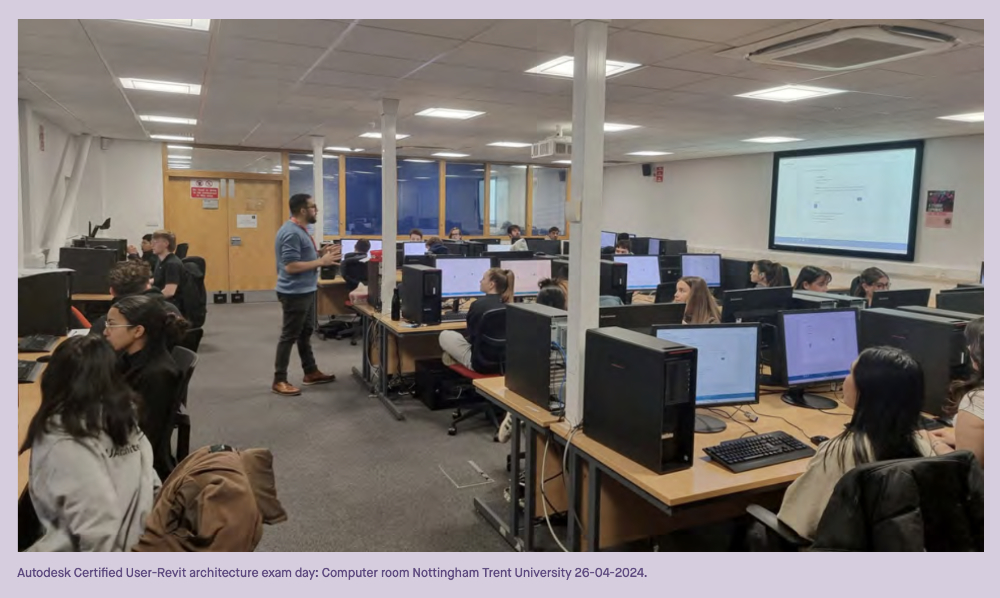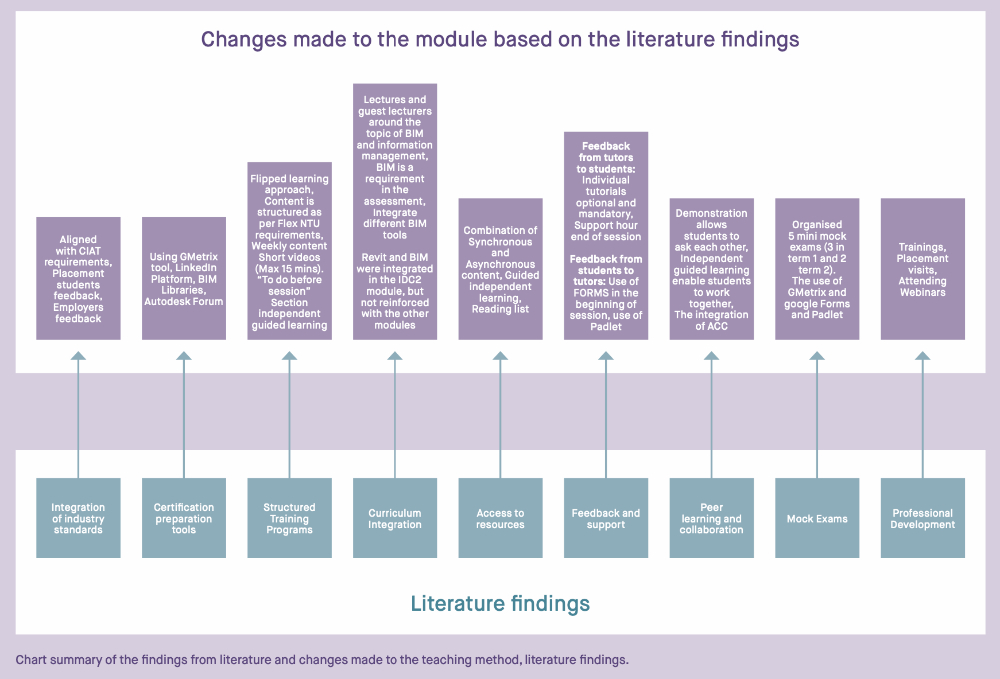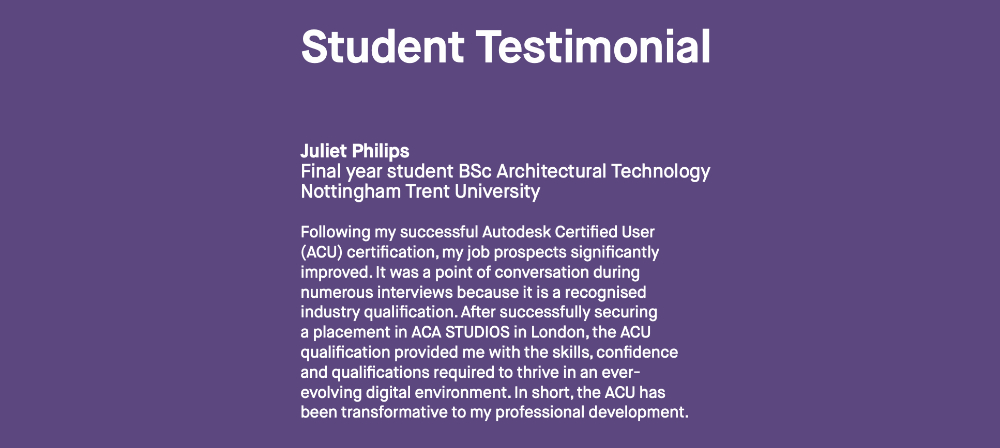Leveraging technology to enhance prospects for students
[edit] A case study on the significance of the Autodesk Revit certification
The Architectural Technology sector is continuously evolving, and as it does the demand for professionals who possess Building Information Modelling (BIM) skills and various industry-recognised certifications is significantly increasing.
In today’s highly competitive job market, employers have the luxury of choosing candidates who excel in challenging exams and possess relevant certifications. These can make a big difference. Autodesk certifications, specifically Autodesk Certified User and Autodesk Certified Professional for Revit Architecture, have become essential in helping Architectural Technology students obtain their desired placements and graduate roles. The certification also allows students obtain a badge that they can display on professional platforms such as LinkedIn, improving their visibility and interview prospects.
These certifications assure employers, showing that the candidate has completed a challenging exam that demands specific skills.
This article delves into the importance of BIM skills and the significance of the Autodesk Certified User for Revit Architecture certification. It presents the findings of two student surveys conducted to assess the impact of the certification on their confidence, development, focus, profile enhancement, and CVs. The survey also explored methods of enhancing teaching techniques and resources to improve students’ success rate.
Two questionnaires were developed and distributed to students to collect data. The first was filled in by Level 5 students after sitting the exam, giving feedback on teaching methods, the students’ experience, preparation tools and competencies. The second was taken by Level 6 students after they completed their placement. It aimed to assess how the certification boosted confidence during placement applications, as well as to assess professional growth and future recommendations. The first was distributed to fifty students, while the second was distributed to a cohort of thirty students.
Regarding their expectations prior to taking the exam, 64% of students said their initial expectation was that the certification was difficult. However, with effective teaching methods (as shown in the chart) a remarkable 90% of students successfully obtained their certificates.
Participants were asked to evaluate different software packages, including AutoCAD, SketchUp, and Revit, based on their personal preferences and suitability for their projects.
87.7% of respondents rated Revit as their top choice, underscoring its widespread favourability, suitability for various project needs and the significance of incorporating the Revit certification into educational curricula.
Participants were asked to evaluate how effective teaching techniques and resources were for Revit exam preparation and obtaining the certificate (results shown in the table). Evaluation of our findings led to us implementing various changes to teaching methods. These in turn have significantly contributed to increasing pass rates among Level 5 students.
An open-ended question asked for students’ advice for those preparing for the certification. They recommended a multifaceted approach involving instructional videos, consistent practice, and actively seeking clarification on uncertainties, which they preferred face-to-face.
In the second survey, when reflecting on their placements, 85% of participants indicated that their Autodesk Revit certification significantly bolstered their confidence, which helped them feel more prepared for the role. 70% of participants stated their Autodesk Revit certification had been significantly valuable for their career development and professional growth. A resounding 93% of respondents highly recommend obtaining the Autodesk Revit certification to fellow students pursuing a career in Architectural Technology.
When asked if they would be interested in pursuing the next step of Revit certification, which is Autodesk Certified Professional (ACP), 100% of students expressed keen interest in furthering their certification journey. This resounding enthusiasm illustrates the importance of these types of qualifications in career advancement and professional development.
We are excited to see what the future holds for the Autodesk Certified Professional (ACP). For our next steps, we are looking to embed ACP into our final year assessments in Digital Design and Building information management.
This article appears in the AT Journal issue 150, summer 2024 as 'Leveraging technology to enhance student prospects: a case study on the significance of the Autodesk Revit certification.' and was written by Dr Nacer Eddine Bezai and Bhavna Crossley, School of Architecture, Design, and the Built environment, Nottingham Trent University.
--CIAT
[edit] Related articles on Designing Buildings
- Appointing consultants.
- Architect.
- Architect's fees.
- Architectural assistant.
- Architectural design.
- Architectural styles.
- Architectural technician.
- Architectural technologist.
- Architectural training.
- CIAT articles.
- Consultant Team.
- Design and technology DT.
- Designers.
- Design methodology.
- How to become an architect.
- Manual drafting techniques.
- Professional Indemnity Insurance.
- Professional Qualifications Bill.
- RIBA National Schools Programme.
- School of Architectural Technology.
- The architectural profession.
- The role of architects.
- The future of architectural education.
Featured articles and news
Gregor Harvie argues that AI is state-sanctioned theft of IP.
Experimental AI housing target help for councils
Experimental AI could help councils meet housing targets by digitising records.
New-style degrees set for reformed ARB accreditation
Following the ARB Tomorrow's Architects competency outcomes for Architects.
BSRIA Occupant Wellbeing survey BOW
Occupant satisfaction and wellbeing tool inc. physical environment, indoor facilities, functionality and accessibility.
Preserving, waterproofing and decorating buildings.
Many resources for visitors aswell as new features for members.
Using technology to empower communities
The Community data platform; capturing the DNA of a place and fostering participation, for better design.
Heat pump and wind turbine sound calculations for PDRs
MCS publish updated sound calculation standards for permitted development installations.
Homes England creates largest housing-led site in the North
Successful, 34 hectare land acquisition with the residential allocation now completed.
Scottish apprenticeship training proposals
General support although better accountability and transparency is sought.
The history of building regulations
A story of belated action in response to crisis.
Moisture, fire safety and emerging trends in living walls
How wet is your wall?
Current policy explained and newly published consultation by the UK and Welsh Governments.
British architecture 1919–39. Book review.
Conservation of listed prefabs in Moseley.
Energy industry calls for urgent reform.
Heritage staff wellbeing at work survey.




























